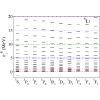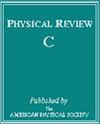Static and dynamic effects of the low breakup threshold of Li6 in complete fusion reactions
IF 3.4
2区 物理与天体物理
Q1 Physics and Astronomy
引用次数: 0
Abstract
We study complete fusion (CF) reactions in collisions of projectiles with , and targets, from sub-barrier energies up to energies well above the Coulomb barrier. For this purpose, we use a recently developed theoretical method, based on continuum discretized coupled channel wave functions, which successfully predicted CF data for heavier systems. To perform the numerical calculations, we developed a computer code where the continuum discretized wave functions are evaluated by the pseudostates method. We investigate the sensitivity of the results to the largest energy used in the continuum discretization, including closed channels. We find that very good convergence is reached by including continuum states with energies up to 15 MeV. We show that the theoretical CF cross sections of the present study reproduce the available data for the , and targets fairly well. A detailed discussion of the static and dynamical effects of the low breakup threshold of the projectile on the CF cross section is presented, considering collisions with targets in different mass regions.

完全聚变反应中 Li6 低破裂阈值的静态和动态效应
我们研究了锂6射弹与Si28、Ni64和Tb159靶碰撞中的完全聚变(CF)反应,从亚势垒能量到远高于库仑势垒的能量。为此,我们使用了最近开发的一种基于连续体离散耦合通道波函数的理论方法,该方法成功地预测了较重系统的 CF 数据。为了进行数值计算,我们开发了一种计算机代码,其中的连续离散波函数通过伪态方法进行评估。我们研究了计算结果对连续离散化所使用的最大能量(包括封闭通道)的敏感性。我们发现,在包含能量高达 15 MeV 的连续态时,可以达到非常好的收敛性。我们表明,本研究的理论 CF 截面很好地再现了 Si28、Ni64 和 Tb159 目标的可用数据。考虑到与不同质量区域的目标碰撞,我们详细讨论了射弹低破裂阈值对 CF 截面的静态和动态影响。
本文章由计算机程序翻译,如有差异,请以英文原文为准。
求助全文
约1分钟内获得全文
求助全文
来源期刊

Physical Review C
物理-物理:核物理
CiteScore
5.70
自引率
35.50%
发文量
0
审稿时长
1-2 weeks
期刊介绍:
Physical Review C (PRC) is a leading journal in theoretical and experimental nuclear physics, publishing more than two-thirds of the research literature in the field.
PRC covers experimental and theoretical results in all aspects of nuclear physics, including:
Nucleon-nucleon interaction, few-body systems
Nuclear structure
Nuclear reactions
Relativistic nuclear collisions
Hadronic physics and QCD
Electroweak interaction, symmetries
Nuclear astrophysics
 求助内容:
求助内容: 应助结果提醒方式:
应助结果提醒方式:


